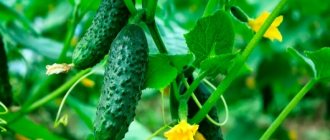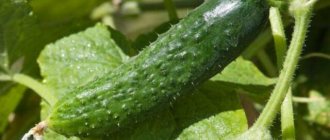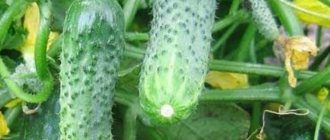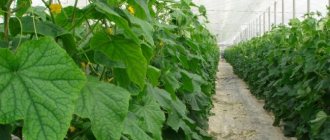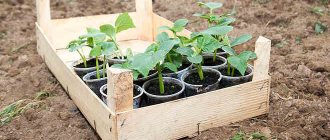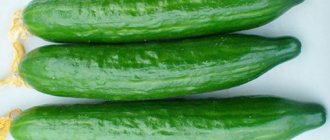Cucumbers are grown not only on an industrial scale, but also in personal backyards. And in greenhouses and hothouse conditions, this vegetable crop makes up more than 2/3 of the total area.
In recent decades, breeders around the world have developed a huge number of varieties and hybrids of this vegetable crop. And vegetable growers prefer to grow mainly cucumber hybrids on their plots - they bear fruit better, are more resistant to diseases, pest attacks, sudden changes in weather conditions, and are able to bear fruit throughout the summer season. And even such a disadvantage as the inability to collect your own seeds from cucumber hybrids is not considered serious enough.
And one of the best and most popular cucumber hybrids is Ecole F1 , which will be discussed below.
Is F1 hybrid GMO?
History of the variety's creation
This hybrid was bred by Dutch breeders from the world-famous seed breeding company Syngenta Seeds. Hybrid Ecole F1, like other cucumbers bred by these breeders, quickly became popular not only in its homeland, but also in other countries of Europe and the world.
In Russia, this hybrid was included in the State Register in 2007. Ecole F1 is recommended for cultivation in the following regions of Russia:
- in the North Caucasus - in garden beds;
- North-Western, West Siberian, Lower Volga, Central Black Earth, East Siberian, Ural - in these areas you can grow the Ecole F1 cucumber both in greenhouse conditions and in garden beds.
F1 - this symbol means that this vegetable plant is a hybrid, and the first generation seed material was used to obtain it. As a result, the plants are high-yielding, disease-resistant, and also have other positive qualities, but their seed material is not suitable for further planting, since the grown plants will not “inherit” the positive qualities of their parents.
Harvest and storage
The Ecole cucumber is one of the few vegetables that is beautiful when unripe, which is why it is harvested that way. Overgrown fruits are suitable mainly for harvesting seeds, since they lose their taste and commercial quality and become like barrels.
The gherkins and pickles of the hybrid must be removed every day in the morning or evening. The stems do not need to be twisted, as this can easily damage the lashes. It is better to cut cucumbers with a knife or pruning shears. If there are yellowed shoots or rotten leaves, these must also be carefully removed.
The collected fruits can be stored for several days in a cool place, after discarding limp and yellowed specimens, since they are not suitable for consumption. Healthy cucumbers can be eaten fresh or used for preservation, given the fact that Ekol F1 pickled and pickled cucumbers are not hollow.
Description of the variety
This hybrid is mid-early - only 1.5 months pass from the moment of germination of the seed material to the harvesting of ripe greens.
Related article:
7 fatal mistakes when growing cucumbers that every gardener should avoid
Cucumbers of the Ecole F1 variety
Since the Ecole F1 hybrid is parthenocarpic, such cucumbers do not require pollination by bees.
Also, Ecole F1 is indeterminate, so the main stem is not limited in growth. The lashes are medium leafy, with an average formation of lateral lashes.
The foliage is small or medium in size, most often three-lobed, smooth and shiny, with small sparse teeth along the edges. The color of the leaf blades is rich emerald.
The flowers are small, yellow in color, collected in bouquet inflorescences formed in the axils of the leaves. Mostly only female flowers are formed in the axils; they can be distinguished by the presence of small ovaries of future cucumbers. In each such inflorescence, up to 5 ovaries are formed.
Ripe cucumbers are cylindrical, weighing up to 72 g. These small gherkins can be up to 9 cm in length. The color of ripe cucumbers is dark emerald, with longitudinal light stripes and barely noticeable spots. The skin is thin, crispy, covered with large tubercles, and has white pubescence.
You can harvest the fruits from this hybrid at the pickle or gherkin stage, then the greens will be tender and juicy. Ripe cucumbers have a beautiful presentation, without bitterness - this is inherent at the genetic level, so the taste of ripe cucumbers is not affected by an abundance of sunlight, insufficient watering, or sudden changes in weather. The pulp is compacted, with a characteristic cucumber aroma.
The harvested crops can be transported to any distance, without their taste and appearance deteriorating. Greens can be stored for quite a long time in appropriate conditions.
Characteristics of Ecole F1 cucumbers
The Ecole cucumber is the brainchild of European breeders. In 2007, the hybrid was entered into the State Register of Russia as a crop intended for cultivation in open and closed beds.
Cucumber Ecole is an early-ripening, self-pollinating hybrid with a bouquet, female type of flowering. The first greens ripen 50 days after planting the seeds.
The plant forms a tall, compact, medium-climbing bush. The height of the main shoot reaches up to 3 m. Thanks to this, Ecole cucumbers bear fruit until the first frost. The bush is densely leafy, covered with dark green leaves of medium size.
Main characteristics
The variety is unpretentious and can be grown in different conditions - in greenhouse conditions or in garden beds.
Productivity
This variety is distinguished by excellent productivity - from each square of area you can collect 18-20 kg of ripe greens. And when growing the Ecole F1 hybrid on an industrial scale, up to 270-290 centners of cucumbers are harvested from each hectare.
Gherkins and pickles should be harvested regularly when they reach a size of 5-8 cm, and new ovaries immediately form on the vines.
Application area
The harvested cucumbers can be used to prepare summer salads and snacks, as well as for pickling and pickling. During heat treatment, the pulp of cucumbers of this variety remains dense and no voids appear in it.
Related article:
Growing cucumbers in a bucket
Diseases and pests
This hybrid is genetically resistant to most diseases that are typical for other varieties of cucumbers. However, during the rainy season or if the rules for caring for cucumber vines are not followed, various types of rot may appear on them. And with prolonged drought, aphids may appear on the Ecole cucumber.
Cucumber diseases: photos of leaves and what to do
Against white rot, it is necessary to treat the plants with copper sulfate or urea, and the area before planting cucumbers is watered with a weak solution of manganese. Also, at the end of the season, it is necessary to remove all remnants of vegetation from the beds.
Downy mildew usually appears on garden foliage. To prevent this disease from affecting the Ecole hybrid, it is necessary not to plant cucumber bushes too close to each other, and water only with warm water.
Seed material and soil should be disinfected with copper sulfate before planting. The bushes are sprayed with Oksikhom or Kurzat solution.
To prevent the bushes of this cucumber from being affected by gray rot, all seed material should be disinfected before planting, the rules of crop rotation should be observed when planting, and greenhouses should be treated with a solution of copper sulfate. All affected parts of the cucumber vines are cut off, and the cut areas are pollinated with wood ash. And the cucumber lashes themselves should be treated with HOM.
To get rid of aphids, you can wash them off with a stream of running water or soapy water. If the aphid colony is too large, then you can use Aktara or Fitoverm.
Taste qualities of cucumbers
According to reviews from gardeners and photos, Ecole F1 cucumbers are small gherkins no more than 12 cm long and weighing up to 100 g. The rich green skin is thin but dense. These qualities make it possible to transport the crop over long distances without losing its presentation. Cylindrical cucumbers are covered with medium-lumpy white spines.
Small gherkins have dense, juicy flesh with a sweet taste. The aroma is bright and rich. Due to the fact that the Ecole cucumber does not form voids and contains few milk seeds, it is used directly from the garden for preparing summer salads and canning for the winter.
Advantages
The main positive qualities of the Ecole F1 include:
- The bushes of this cucumber bear fruit for a long time - from the second ten days of June to the second ten days of September, or even later;
- this hybrid is unpretentious and can be grown both in garden beds and in greenhouse conditions;
- collected gherkins and pickles are devoid of bitterness, so their taste is not affected by unfavorable weather conditions, lack of regular watering and excess light;
- the variety is characterized by increased resistance to diseases such as olive spot, viral cucumber mosaic, powdery mildew;
- the yield of Ekol F1 cucumber is much higher than that of other similar hybrids;
- The hybrid is self-pollinating, so it grows and bears fruit well in greenhouses and film greenhouses.
Related article:
Cucumber Emerald earrings F1 - description and characteristics of a high-yielding early-ripening hybrid
Soil preparation
The soil in the garden or greenhouse must be prepared in advance for planting cucumbers. To do this you need to take the following steps:
- In the fall, remove all tops and weeds from the garden bed, and in greenhouse conditions it is advisable to completely remove the top layer of soil. Dig up the soil using a spade and add organic fertilizer.
- 21 days before planting, warm the soil and destroy pathogenic microflora by adding horse manure. An alternative option is bird droppings, but this must be applied 14 days before planting. If organic matter is added immediately before planting, this will lead to burning of the seeds or roots of the seedlings.
- Immediately before planting, dig up the soil again, apply fertilizer and water with warm water.
Before planting, the soil should be moist and well fertilized so that the sprouts can quickly adapt to new germination conditions.
Landing
To get high yields from this hybrid, you need to choose the right soil, follow the irrigation regime and apply fertilizing in a timely manner.
This hybrid grows best on loamy soil, which allows moisture and oxygen to pass through well. You need to choose a place for planting cucumbers in well-lit areas that are protected from gusts of cold wind.
When growing this variety, you must follow the rules of crop rotation and plant the hybrid only after certain vegetable crops - onions, tomatoes, carrots. But after plants such as pumpkins, zucchini, squash, melons and watermelons, you should not plant cucumbers, since they are all affected by the same types of diseases.
The best neighbors for this hybrid will be sunflower and any types of greenery. But it is better to plant potatoes and herbs further away.
Also, these cucumbers should not be planted in low-lying areas, or where groundwater comes too close to the soil surface - stagnation of water can lead to root rot.
Optimal growing conditions
The amount of harvest depends not only on the varietal characteristics, but also on the correctly chosen location, preparation of the bed and soil. The Ecole cucumber loves a well-lit place with nutritious, well-drained soil. The best predecessors for cucumber are tomatoes, peppers, legumes and cereals. It is not recommended to grow cucumbers after pumpkin, zucchini and watermelon.
In regions with a warm climate, where summer temperatures range between + 25-30 °C, Ecole cucumber is best grown outdoors.
Important! In cities with a temperate climate, gherkins are grown under film cover, since cold temperatures down to + 5 °C have a detrimental effect on young seedlings.
Planting seeds in open ground
hands with cucumber seeds above the ground
Seeds of this variety in the southern regions can be planted in open ground as early as early May, and in colder regions it is better to plant plants in film greenhouses or greenhouses.
It is also recommended to plant cucumbers of this hybrid in seedlings, with the seeds planted at home about a month before the intended transplantation of the plants to a permanent location.
Seed material can be planted in open ground approximately in the middle of the second ten days of May. And seedlings for seedlings are planted around the second ten days of April.
Holes for planting seeds in the garden are made at a distance of 10-12 cm. The soil on the site should be loose and fertilized. Place 2-3 seeds in each hole and bury them to a depth of 2 cm.
Related article:
Shaping cucumbers - you can’t do without it. You will regret the lower ones, you will be left without the upper harvest
After the shoots appear, they need to be thinned out, leaving a distance between them of 12-14 cm. When real leaves appear, the cucumbers need to be thinned out again, leaving a distance of 28-30 cm between them.
Advantages and disadvantages of the variety
The obvious advantages of the variety include the following qualities::
- high productivity;
- long fruiting period;
- resistance to many diseases;
- lack of bitterness even with rare watering;
- self-pollinating.
There are also disadvantages:
- overripe fruits have a hard skin;
- since this is a hybrid and not a variety, you will have to buy seeds every time;
- they have characteristic spikes.
Planting seedlings
In order for cucumbers of this variety to begin to bear fruit earlier, it is recommended to grow them using seedlings. Since cucumbers do not tolerate transplantation well, the seed material is planted immediately in separate cups.
Cucumber seedlings
For planting, it is better to purchase a ready-made nutrient substrate from a specialized store. But you can prepare such a soil mixture yourself by mixing peat, humus, turf and sand in a ratio of 4:4:2:1.
A pair of seeds are planted in each cup of moistened soil, covered with polyethylene and placed in a warm place for germination.
The optimal temperature for growing cucumber seedlings is about 16 degrees Celsius at night and 22 degrees Celsius during the day.
Seedlings should be watered with warm water twice a week. After the seedlings have grown a little, leave one stronger plant in each container.
Also, seedlings are fed with mullein after the first true leaf appears, and after two leaves appear, they are watered with nitrophoska.
When the plants have at least 4 leaves, they can be transplanted into garden beds or a greenhouse.
Before planting, you need to prepare the beds - add humus to them (for each square of area - 10 kg). The cucumbers are watered, then, together with a lump of earth, transferred to the prepared holes.
The seedling planting pattern is 0.3*0.6 m. In this case, no more than 5 cucumber vines should grow on each square.
After the seedlings are planted, they need to be shaded for the first few days so that they acclimatize more easily and quickly in their new location.
Productivity
Ecole cucumbers are an indeterminate variety; subject to proper care, the harvest can be harvested from late May to mid-September. Cucumbers are small but numerous. From 1 sq. m you can remove up to 20 kg of crispy and aromatic greens. Due to its high yield, good taste and external qualities, the Ekol variety is suitable for growing not only on a personal plot, but also on an industrial scale.
Ecole cucumbers ripen 40-50 days after seed germination. Harvesting is carried out several times a week, as overripe gherkins lose their aroma and elasticity.
Further care
Further care for this hybrid is not so difficult. First of all, it is necessary to form the lashes correctly. The Ecole cucumber grows shoots very quickly, as well as side shoots. Therefore, it is better to form the bushes into one stem and remove all other shoots. But several side shoots should be left, since ripe fruits are first collected from the main shoot, and then from the side stems.
Related article:
Planting cucumbers in open ground: tips and tricks
After transplantation, the growing seedlings begin to be tied to trellises. When the central stem grows to the top of the trellis, you need to pinch off the top. All side stems below the third permanent leaf must be removed, leaving only a few side shoots, the tops of which are pinched off above the third leaves.
Irrigation regime
Cucumbers should be watered 2-3 times a week, and daily during the period of active fruit growth. 3 buckets of water should be added to each square of the area. During periods of drought, cucumbers should be watered more often, but during the rainy season no additional watering is required.
Water for irrigation should be warm. It is better to arrange drip irrigation in the greenhouse.
Loosening and weeding
After rains and watering, it is necessary to carefully loosen the root zone of cucumber vines. At the same time, you need to remove all weeds along with the roots.
Feeding
To ensure abundant fruiting of this hybrid, Ekol should be fed several times a season. 1.5-2.0 weeks after transplantation, Diammofoska granules should be embedded in the root zone of cucumber vines. And after another 12-14, such fertilizer should be applied again. During the period of active fruiting, once a week, fertilizers containing potassium are applied under these cucumber vines every 6-8 days.
Agricultural technology for cucumbers Ecole F1
Properly planted seeds and seedlings, adherence to care techniques - all this affects the quality and quantity of the harvest. Despite the fact that the Ecole cucumber is an undemanding crop, when growing it requires a minimum of effort and maximum care.
Planting seedlings
To get early fruiting, it is better to grow Ecole cucumber using seedlings. To grow a rich harvest, you need to choose the right planting time. Since the Ecole cucumber is an early-ripening hybrid, the seedlings are transplanted at the age of 25-30 days, with 3-4 true leaves. To this add a week for seed germination and minus 1 month from the usual date of the last frost. As a result, you can calculate the time for planting seeds for seedlings.
Ecole cucumbers do not tolerate transplantation very well, so experienced gardeners recommend growing seedlings in separate containers. Cucumbers prefer to grow in nutritious soil. You can buy it at the store or prepare it yourself. To do this, mix wood soil, peat, rotted humus and sawdust in equal proportions. You can also add 500 g of wood ash for every 10 liters of prepared soil.
Technique for planting Ecole cucumber seeds for seedlings:
- Fill the cups to ¾ of the volume with the prepared soil mixture.
- The seeds are buried 1-2 cm.
- The container is covered with polyethylene to create a microclimate and put in a warm place.
- After the sprouts appear, the containers are transferred to the brightest but coolest place. Coolness will help the plant grow its root system and not stretch out.
- After a week, the strongest sprout is left, removing all the weak ones (carefully cut, not pulled out).
- The seedlings are hardened off 3-4 days before planting.
- After the formation of 4-5 leaves, the seedlings will be ready to be transferred to a permanent location.
Before planting cucumbers in a permanent place, they need to be fed several times. The first fertilizing, liquid mullein, is applied after the first true leaf appears. A week later, phosphorus-potassium fertilizers are applied.
Important! Poorly fertilized soil, lack of sunlight and dense planting have a bad effect on the growth of Ecole cucumber seedlings; they stretch out and weaken.
It is not recommended to grow seedlings on a windowsill for more than a month. Since it will outgrow, it will not take root well, it may get sick and will not bring the expected result.
After the soil has warmed up and the spring frosts have ended, the seedlings can be transferred to a permanent location. Transplanting:
- The bed is dug up and filled with manure or rotted humus at the rate of 10 liters per 1 sq. m.
- The plant is shed generously and carefully removed from the container, being careful not to damage the root system.
- Since the Ecole cucumber is a tall variety, the planting pattern is 30x60 m. The seedlings are planted in a checkerboard pattern, buried 15 cm along with a lump of earth.
- The seedling is sprinkled with soil up to the cotyledon leaves.
- The planting is spilled with warm water and mulched.
Landing in the ground
Seeds can be sown in open ground only when the soil is warmed to + 15 °C. As a rule, seeds are not treated with a growth stimulant, since manufacturers cover the planting material with a special coating. The order of sowing cucumber seeds Ecole:
- In a prepared, fertilized, well-watered bed, holes are made at a distance of 30 cm.
- 2-3 seeds are buried 2 cm in each hole.
- After planting, the ground is mulched and covered with agrofibre.
- After 2 weeks, the seedlings are thinned out, leaving larger and healthier ones.
Advice! From the description, reviews and photos it is clear that Ecole F1 cucumbers are an indeterminate variety, therefore, per 1 sq. m plant no more than 3-4 plants.
Watering and fertilizing
It is impossible to get the long-awaited harvest of Ecole cucumbers without following agrotechnical rules.
Watering when growing cucumbers is the most important aspect of care. Because with a lack of moisture, cucumbers will grow low-juiced, bitter and not aromatic. Irrigation is carried out in the morning and evening hours with warm, settled water. Before flowering, watering is carried out several times a week, as the soil dries out. During fruiting, it is better to irrigate 4 times every 7 days, using about 10 liters of water for each bush.
Advice! When growing Ecole cucumbers in open beds in dry summers, watering is carried out more frequently and more abundantly.
It is unacceptable to irrigate with cold water, as it can lead to rotting of the root system and the formation of blackleg.
After watering, the soil is loosened. To make work easier, it is better to mulch the soil. It will retain moisture, prevent grass from sprouting, and will serve as an additional organic fertilizer.
For good, stable fruiting, the Ecole cucumber must be fed several times a season:
- 10 days after planting the seedlings, complex mineral fertilizers are applied, diluted strictly according to the instructions.
- After 2 weeks, 3 liters of fertilizer are applied to each cucumber (40 g of the drug “Nitrophoska” diluted in 10 liters of water).
- During the period of fruit formation, cucumbers are fed with potassium (30 g, diluted in a bucket of warm water).
Very often, experienced gardeners are inclined to fertilize with folk remedies. Bread kvass is used as a nutritional preparation. The pan is filled 2/3 of the volume with bread crusts, filled with warm water and put in a warm place for fermentation for 7 days. The finished solution is diluted with water in a ratio of 1:3. For each bush, 0.5 liters of the finished product is used.
Advice! A lack of fertilizer, as well as an excess, negatively affects the growth and development of the Ecole cucumber.
A lack or excess of nutrients can be determined by the appearance of the plant:
- lack of nitrogen - the leaf blade becomes lighter, the number of ovaries is reduced;
- excess nitrogen fertilizers – poor fruit formation, active growth of green mass;
- lack of potassium - stretching of the lashes, a yellow rim appears on the leaf blade, fruits are poorly formed;
- excess potassium - internodes lengthen, gherkin growth slows down.
Formation
Cucumber Ecole is an indeterminate variety; it has unlimited growth of vines with weak branching of side shoots. A hybrid with a bunch type of flowering is formed into 1 stem:
- After planting the seedlings, they are tied to a support.
- When the main stem grows to the required size, the top is pinched.
- All side shoots, flowers and ovaries up to the 3rd leaf blade are removed. This process is called blinding.
- The shoot formed from 4 to 6 leaves is left, and the pinching is done over the 3rd leaf, leaving 1 fruit.
- The lashes formed above the 7th leaf are cut off, leaving a length of 40 cm and 2 green leaves.
- Next, the side lashes are left up to half a meter long and 3 cucumbers.
Blinding has a beneficial effect on the growth and development of cucumbers. Since the fruits that set on the lower part draw a lot of strength and do not allow the plant to grow a powerful root system and prevent further fruiting in the upper parts of the bush.
Baring the lower area will improve air exchange and help protect the plant from the formation of root rot.
Ecole cucumber is best grown on a support. The garter is carried out when the plant grows to 30 cm and grows 3-4 true leaves. You can use a vertical or horizontal garter.
If Ecole cucumbers are not tied up, the shoots with fruits will come into contact with the soil, which will lead to difficult watering and harvesting, as well as to the occurrence of various diseases.
Protection from diseases and pests
Description of the variety, reviews and photos indicate good resistance of the Ecole cucumber to many diseases. But under unfavorable climatic conditions and rainy summers, the risk of pests and the development of fungal diseases increases.
Common diseases of Ecole cucumber, methods of treatment:
- White rot. The pathogen appears at high humidity and low air temperature. The stem and leaf blade become covered with white bloom and mucus, and the fruits rot. When fungus appears, all affected parts are removed and burned. The cut area is treated with charcoal or brilliant green. The bush is also sprayed with a solution prepared from copper sulfate (2 g) and urea (10 g) diluted in 10 liters of water.
- Downy mildew. The fungus affects the entire above-ground part. Light lemon-colored spots appear on the leaf blade of the Ecole cucumber, the buds and flowers turn black and fall off. Without treatment, the plant quickly begins to wither and dies. Help consists in treating the bush with a 0.5% solution of “Kurzat”, “Oxychoma”.
- Gray rot. The leaves and stem of the Ecole cucumber become covered with light spots, the fruits become covered with a gray coating and become soft and watery. When a disease appears, remove all damaged parts and disinfect the plant with a 0.5% HOM solution.
Insect pests that often appear on cucumber crops:
- Whitefly. The insect feeds on the sap of the plant. At the same time, growth and fruiting stops. A rapid invasion is observed in warm weather. When a pest appears, the Ecole cucumber is sprayed with dandelion infusion or Confidora for 30 days.
- Aphid. Colonies of pests settle on leaves and stems. By sucking out the juice, they weaken the plant and reduce fruiting. Before the fruit appears, the bush is sprayed with Fitoverma or a soap solution.
- Spider mite. Appears on the inside of the leaf blade, covering it with a thin web. In the evening, cucumbers are sprayed with Fitoverma twice with an interval of 2 weeks.
Important! To control cucumber pests, you can use any broad-spectrum insecticide.
In order not to encounter dangerous diseases and not to see pest invasions, it is necessary to follow preventive measures:
- observe crop rotation;
- do not thicken plantings;
- regularly loosen the soil;
- Watering should be done only with warm water;
- remove weeds in a timely manner, as they are carriers of many diseases;
- Plant marigolds, calendula or herbs next to the cucumber crop.
Reviews from gardeners
Alexandra, 40 years old, Moscow region
I have been growing this variety of cucumbers for several years. I really like the fact that Ekol begins to bear fruit quickly and can be harvested throughout the summer. My family has enough harvest from this variety not only for food, but also for spinning for the winter. Ripe gherkins are tasty and crispy.
Tatyana, 50 years old, Samara region
I grow cucumber Ecole on my plot in a greenhouse. I can say that these vegetables did not suffer from any disease, they bore fruit well, and they tasted better than Satina, for example.
The Dutch cucumber selection Ecole is distinguished by its high yield, resistance to disease and ease of care. That is why it is so popular among vegetable growers from around the world.
Advantages and disadvantages
Gardeners have admired the Ecole cucumber due to its following advantages:
- has a stable and high yield (110 t/ha);
- characterized by intensive fruit set (forms up to 9 ovaries from each fruiting node);
- can form fruit ovaries without pollination;
- is highly resistant to tobacco mosaic virus and powdery mildew;
- the fruits are distinguished by their high marketability (the ratio of the length and width of the gherkin is 3:1);
- produces excellent pickles, sweet in taste and without bitterness.
The disadvantages of the hybrid include:
- the presence of prickly thorns on the fruits;
- loss of taste and excessive thickening of fruits when harvested at the wrong time;
- lack of tolerance to downy mildew (downy mildew).
Hydride Ecole F1 is the latest parthenocarpic cucumber of Dutch selection with a mid-early ripening period, which shows excellent survival rate and adaptation to cultivation in the conditions of central Russia. The variety is considered undemanding to care, but to get a good harvest it is important to adhere to all the rules of agricultural technology.
3
0
Copy link
Diseases and pests
Although the Ecole cucumber variety is considered a disease-resistant species, it can be affected by downy mildew, white rot and tobacco mosaic. As a prevention and treatment, spraying with copper sulfate, Bordeaux mixture or mullein solution is used. Affected areas of plants must be removed immediately to avoid spreading to neighboring bushes. The main cause of diseases is high humidity or improper care, non-compliance with crop rotation rules.
Of the pests, the main enemies of Ecole cucumbers are:
- whitefly: fight the pest with a soap solution and sticky traps; prevention is by following the rules of crop rotation and adding manure to the soil;
- spider mites: when pests appear, treat the bushes with pepper infusion;
- melon aphid: fight insects using a solution of karbofos.
The need for supports and garters
Greenhouse cultivation of the hybrid involves the use of supports that hold the bush in a vertical position, which allows you to maximize the number of plants and obtain high yields of strong and healthy fruits that are not susceptible to diseases that often arise from contact with the soil. In addition, well-attached bushes make caring for them much easier. As supports, experienced gardeners recommend simple garters on cords or a device such as a trellis - a lattice of wooden or plastic slats with different cell sizes (from 20 to 50 cm). Tie up shoots as they grow
How to grow
Growing Ecole cucumbers is not difficult. Medium loamy soil with pronounced looseness is best suited for them.
Planting by seeds and seedlings
Cucumbers of this hybrid can be planted in open ground using seeds or seedlings. It is recommended to make beds in places where certain previous crops grew last year:
- potatoes - provided that no chemicals were used to grow this crop last season;
- pepper – we mean sweet varieties;
- cabbage;
- onions are the most suitable option.
The place should be well lit, but without drafts.
Planting in open ground in warm regions is carried out in the following stages:
- begin at the end of spring, when the average air temperature reaches +15 °C;
- Initially, the seeds are soaked overnight in a nutrient solution of nitrophoska with ash;
- Holes are made in advance in the garden bed with an interval of a little more than 10 cm in the row;
- the distance between rows is determined to be 60 cm;
- the holes are watered with heated water;
- seeds are sown to a depth of 2-3 cm and covered with earth;
- It is recommended to plant several seeds in one hole in order to later carry out a dive with a selection of the strongest plants;
- crops are covered with film until shoots emerge.
The seedling method speeds up harvesting by 10-15 days. It is preferable to plant the Ecole hybrid immediately in separate cups with a capacity of 0.3–0.5 liters, since when planted early, the seedlings do not tolerate picking well.
First of all, prepare the soil. It is recommended to bake a mixture of peat, leaf humus, sawdust and soil in the oven for 40-60 minutes - this will destroy pests and fungal spores. You can buy ready-made soil mixture at a specialty store.
Further algorithm:
- Fill the cups with soil mixture and plant the seeds to a depth of about 3 cm.
- Moisten the soil with warm water and place the containers in a well-lit place, covered with film.
- After the first leaves appear, the film is removed. The soil continues to be watered regularly, avoiding waterlogging.
- If there is insufficient daylight, additional lighting must be provided. Two weeks before planting in open ground, the seedlings are hardened by taking them out to the balcony or yard for a short time.
- When 3-4 true leaves appear, which acquire a distinctly bright green color, begin planting. Otherwise, the sprouts will stretch out and take root poorly. At the time of planting in open ground, the seedlings should reach a height of about 30 cm.
Features of cultivation and possible difficulties
Water the plants every 3-4 days with warm water in the early hours or in the evenings.
For 1 sq. m consumes 25–30 liters of water.
Watering largely depends on the weather. In hot, sultry periods, the intensity of this procedure is increased, and in rainy periods, vice versa.
It is also recommended to follow the following rules:
- It is better to water by sprinkling or along furrows;
- Do not use a powerful stream of water on the bush - strong pressure will damage the root system, which in this hybrid is located close to the surface;
- avoid getting water on the leaves, especially in hot weather;
- It is advisable to loosen after each watering.
Seedlings are regularly fed with mullein, bird droppings or ash. You can also use special mineral fertilizers.
Tying the bush to a support is necessary, as it tends to stretch several meters. If the stem falls to the ground, the fruits in contact with it will become infected with diseases or become deformed.
When the seventh stem is formed, it is recommended to pinch the main one. Then select and leave one or two strong stems. The ovaries on the lower internodes should be removed - it is believed that this technique will increase the fruiting of the bush.
During the growing season, you need to know the features of growing cucumbers, which will help you avoid difficulties:
- If the soil is not loose enough, the development of the root system will slow down, and you will have to carry out the procedure every day, including after every rain.
- The bush's growth may suddenly slow down. This happens after too vigorous removal of unnecessary stems: feed the plant with organic matter.
- Each mineral fertilizer is first applied in small doses, otherwise the effect of fertilizing may be the opposite: all plants react to the procedure individually.
Watering
Watering cucumbers should be regular, preferably in the evening or early morning hours, so that the sun's rays, concentrating in water drops, like in lenses, do not damage the delicate leaves. During drought, cucumber crops are moistened twice a day.
The best time to water is evening
Lack of moisture is the cause of deterioration in the taste of cucumbers and their yellowing.
